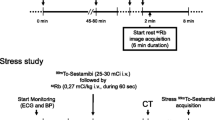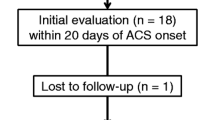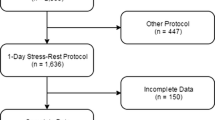Abstract
Background
This study was designed to compare the results of rest-redistribution thallium-201 imaging with those of rest technetium 99m furifosmin single photon emission computed tomography in the same patients with chronic ischemic left ventricular (LV) dysfunction.
Methods
Twenty-one patients (mean age 62±9 years) with chronic myocardial infarction and LV dysfunction (mean LV ejection fraction 34%±8%) underwent rest-redistribution thallium imaging and resting furifosmin single photon emission computed tomography on the same day. In each patient, regional thallium and furifosmin activity was quantitatively measured in 13 myocardial segments. Regional LV function was assessed in corresponding segments by echocardiography.
Results
At thallium imaging, 91 (33%) segments had normal uptake, 16 (6%) showed reversible defects, and the remaining 166 (61%) irreversible defects. Of these 166 irreversible defects, 74 (45%) had moderate (≥58% of peak activity) and 92 (55%) severe (<58% of peak activity) reduction of thallium uptake. Regional furifosmin uptake was significantly related to both rest (r=0.87, P<.0001) and redistribution (r=0.90, P<.0001) thallium activity. Agreement in the evaluation of regional perfusion status between thallium and furifosmin imaging was observed in 70% of the 84 hypokinetic segments (κ=0.54) and in 76% of the 78 akinetic or dyskinetic segments (κ=0.60). Concordance in the detection of myocardial viability between thallium and furifosmin imaging was observed in 69 (82%) of hypokinetic regions (κ=0.60) and in 65 (83%) of akinetic or dyskinetic regions (κ=0.67).
Conclusions
These results suggest that in patients with chronic coronary artery disease and LV dysfunction, quantitative rest-redistribution thallium scintigraphy and furifosmin tomography at rest provide similar results in the evaluation of perfusion status and in the detection of myocardial viability.
Similar content being viewed by others
References
Rossetti C, Vanoli G, Paganelli G, et al. Human biodistribution, dosimetry and clinical use of technetium(III)-99m-Q12. J Nucl Med 1994;35:1571–80.
Gerson MC, Millard RW, Roszell NJ, et al. Kinetic properties of Tc-99m Q12 in canine myocardium. Circulation 1994;8:1291–300.
Hendel RC, Verani MS, Miller DD, et al. Diagnostic utility of tomographic myocardial perfusion imaging with technetium 99m furifosmin (Q12) compared with thallium 201: results of a phase III multicenter trial. J Nucl Cardiol 1996;3:291–300.
Gerson MC, Lukes J, Deutch E, Biniakiewicz D, Washburn LC, Walsh RA. Comparison of imaging properties of technetium 99m Q12 and technetium 99m Q3 in humans. J Nucl Cardiol 1995;2:224–30.
Braunwald E, Rutherford JD. Reversible ischemic left ventricular dysfunction: evidence for “hibernating” myocardium. J Am Coll Cardiol 1986;8:1467–70.
Dilsizian V, Bonow RO, Cannon RO, et al. The effect of coronary artery bypass grafting on left ventricular systolic function at rest: evidence for preoperative subclinical myocardial ischemia. Am J Cardiol 1988;61:1248–54.
Bonow R, Dilsizian V, Cuocolo A, Bacharach SL. Identification of viable myocardium in patients with chronic coronary artery disease and left ventricular dysfunction. Comparison of thallium scintigraphy with reinjection and PET imaging with 18F-fluorodeoxyglucose. Circulation 1991;83:26–37.
Berman DS. Technetium-99m myocardial perfusion imaging agents and their relations to thallium-201. Am J Cardiol 1990;66:1–4E.
Maddahi J, Kiat H, Berman DS. Myocardial perfusion imaging with technetium-99m-labeled agents. Am J Cardiol 1991;67:27–34D.
Cuocolo A, Acampa W, Nicolai E, et al. Quantitative thallium-201 and technetium 99m sestamibi tomography at rest in detection of myocardial viability in patients with chronic ischemic left ventricular dysfunction. J Nucl Cardiol 2000;7:8–15.
Udelson JE, Coleman PS, Metherall J, et al. Predicting recovery of severe regional ventricular dysfunction: comparison of resting scintigraphy with 201Tl and 99mTc sestamibi. Circulation 1994;89:2552–61.
Matsunari I, Fujino S, Taki J, et al. Myocardial viability assessment with Tc-99m-tetrofosmin and thallium-201 reinjection in coronary artery disease. J Nucl Med 1995;36:1961–7.
Cuocolo A, Petretta M, Nicolai E, et al. Successful coronary revascularization improves prognosis in patients with previous myocardial infarction and evidence of viable myocardium at thallium-201 imaging. Eur J Nucl Med 1998;25:60–8.
Petretta M, Cuocolo A, Bonaduce D, et al. Incremental prognostic value of thallium reinjection after stress-redistribution imaging in patients with previous myocardial infarction and left ventricular dysfunction. J Nucl Med 1997;38:195–200.
Shiller NB, Shah PM, Crawford M, et al. American Society of Echocardiography committee on standards, subcommittee on quantitation of two-dimensional echocardiograms: recommendations for quantitation of the left ventricle by two-dimensional echocardiography. J Am Soc Echo 1989;2:358–67.
Cuocolo A, Nicolai E, Petretta M, et al. One-year effect of myocardial revascularization on resting left ventricular function and regional thallium uptake in chronic CAD. J Nucl Med 1997;38:1684–92.
Fleiss JL. Statistical methods for rates and proportions. 2nd ed. New York: Wesley and Sons; 1981.
Iskandrian AS, Hakki A, Kane SA, et al. Rest and redistribution thallium-201 myocardial scintigraphy to predict improvement in left ventricular function after coronary arterial bypass grafting. Am J Cardiol 1983;51:1312–6.
Ragosta M, Beller GA, Watson DD, Kaul S, Gimple LW. Quantitative planar rest-redistribution 201-Tl imaging in detection of myocardial viability and prediction of improvement in left ventricular function after coronary bypass surgery in patients with severely depressed left ventricular function. Circulation 1993;87:1630–41.
Mori T, Minamiji K, Kurogane H, Ogawa K, Yoshida Y. Rest-injected thallium-201 imaging for assessing viability of severe asynergic regions. J Nucl Med 1991;32:1718–24.
Marzullo P, Sambuceti G, Parodi D, et al. Regional concordance and discordance between rest thallium 201 and sestamibi imaging for assessing tissue viability: comparison with postrevascularization functional recovery. J Nucl Cardiol 1995;2:309–16.
Kauffman GJ, Boyne TS, Watson DD, Smith WH, Beller GA. Comparison of rest thallium 201 imaging and rest technetium-99m sestamibi imaging for assessment of myocardial viability in patients with coronary artery disease and severe left ventricular dysfunction. J Am Coll Cardiol 1996;27:1592–7.
Matsunari I, Fujino S, Taki J, et al. Quantitative rest technetium-99m tetrofosmin imaging in predicting functional recovery after revascularization: comparison with rest-redistribution thallium-201. J Am Coll Cardiol 1997;29:1226–33.
Tamaki N, Takahashi N, Kawamoto M, et al. Myocardial tomography using technetium-99m tetrofosmin to evaluate coronary artery disease. J Nucl Med 1994;35:594–600.
Maublant JC, Marcaggi X, Lusson JR, et al. Comparison between thallium-201 and technetium-99m methoxyisobutyl isonitrile defect size in single-photon emission computed tomography at rest, exercise and redistribution in coronary artery disease. Am J Cardiol 1992;69:183–7.
Leon AR, Eisner RL, Martin SE, et al. Comparison of single-photon emission computed tomographic (SPECT) myocardial perfusion imaging with thallium-201 and technetium-99m sestamibi in dogs. J Am Coll Cardiol 1992;20:1612–25.
Galassi AR, Tamburino C, Grassi R, et al. Comparison of technetium 99m-tetrofosmin and thallium-201 single-photon emission computed tomographic imaging for the assessment of viable myocardium in patients with left ventricular dysfunction. J Nucl Cardiol 1998;5: 56–63.
Author information
Authors and Affiliations
Corresponding author
Rights and permissions
About this article
Cite this article
Cuocolo, A., Rubini, G., Acampa, W. et al. Technetium 99m furifosmin regional myocardial uptake in patients with previous myocardial infarction: Relation to thallium-201 activity and left ventricular function. J Nucl Cardiol 7, 235–241 (2000). https://doi.org/10.1016/S1071-3581(00)70012-2
Received:
Accepted:
Issue Date:
DOI: https://doi.org/10.1016/S1071-3581(00)70012-2




